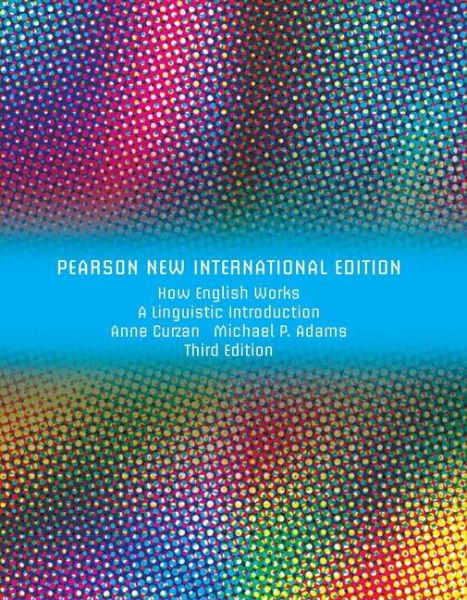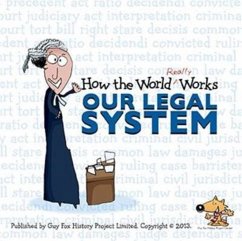
How English Works: A Linguistic Introduction
Pearson New International Edition

PAYBACK Punkte
51 °P sammeln!
This accessible introduction to the structure of English, general theories in linguistics, and important issues in sociolinguistics, is the first text written specifically for English and Education majors.
This engaging introductory language/linguistics textbook provides more extensive coverage of issues of particular interest to English majors and future English instructors. It invites all students to connect academic linguistics to the everyday use of the English language around them. The book’s approach taps students’ natural curiosity about the English language. Through exercises and discussion questions about ongoing changes in English, How English Works asks students to become active participants in the construction of linguistic knowledge.
Features + Benefits
Focuses on issues especially important to English majors, such as American dialects, descriptive and prescriptive approaches to English grammar, the history of English, English spelling, stylistics, language attitudes, and language education.
Current examples and exercises tie the linguistic material to students’ everyday experiences with the English language. Each chapter opens with a scenario that highlights key issues covered in the chapter.
Featuring a building block approach, the text begins with an introduction to the foundations of systematic language study and the relationship of language and authority in chapters 1 and 2, and then progresses “up” through the levels of language structure, from phonology through syntax and semantics to discourse and sociolinguistics.
Focuses on the social and political issues surrounding the English language.
Attention to the history of English throughout the text culminates in two final chapters focused on the past and future of English.
Includes a wealth of useful pedagogical material, clarifying or detailing text topics and prompting student participation: Discussion, Scholar Profile, and Linguistic Inquiry boxes; in-chapter exercises; end-of-chapter suggested readings; and a glossary of linguistic terminology.
Brief Contents
Glossary
Inside Front Cover Dialect Map of American English, Consonant Phonemes of American English, Vowel Phonemes of American English
Inside Back Cover Brief Timeline for the History of the English Language
Detailed Contents
List of Symbols, Linguistic Conventions, and Common Abbreviations
What’s New to This Edition
Preface to Instructors
Letter to Students
Chapter 1 A Language like English
Chapter 2 Language and Authority
Chapter 3 English Phonology
Chapter 4 English Morphology
Chapter 5 English Syntax: The Grammar of Words
Chapter 6 English Syntax: Phrases, Clauses, and Sentences
Chapter 7 Semantics
Chapter 8 Spoken Discourse
Chapter 9 Stylistics
Chapter 10 Language Acquisition
Chapter 11 Language Variation
Chapter 12 American Dialects
Chapter 13 History of English: Old to Early Modern English
Chapter 14 History of English: Modern and Future English
Bibliography
Credits
Index
Detailed Table of Contents
Glossary
Inside Front Cover Consonant Phonemes of English, Vowel Phonemes of English, Phonetic Alphabet for American English
Inside Back Cover Brief Timeline for the History of the English Language
List of Symbols, Linguistic Conventions, and Common Abbreviations xviii
What’s New to This Edition
Preface to Instructors
Letter to Students
Chapter 1 A Language Like English
The Story of Aks
Language, Language Everywhere
The Power of Language
Name Calling
Judging by Ear
A Question to Discuss: What Makes Us Hear an Accent?
The System of Language
Arbitrariness and Systematicity
A Scholar to Know: Ferdinand de Saussure (1857–1913)
Creativity
Grammar
Linguistics
Human Language versus Animal Communication
Birds and Bees
Chimps and Bonobos
Distinctive Characteristics of Human Language
The Process of Language Change
Language Genealogies
A Question to Discuss: Can Your Language Peeves Be Rethought?
Mechanics of Language Change
Progress or Decay?
Special Focus: Attitudes about Language Change
Summary
Suggested Reading
Exercises
Chapter 2 Language and Authority
Who Is in Control?
Language Academies
Language Mavens
A Question to Discuss: Does the SAT Know Good Grammar from Bad?
Defining Standard English
Descriptive versus Prescriptive Grammar Rules
Case Study One: Multiple Negatives
Case Study Two: Ain’t
Case Study Three: Who and Whom
The Status of Prescriptive Rules
Spoken versus Written Language
A Question to Discuss: Are We Losing Our Memories?
Dictionaries of English
The Earliest Dictionaries of English
The Beginnings of Modern Lexicography
Historical Lexicography
American Lexicography
A Question to Discuss: Should Dictionaries Ever Prescribe?
English Grammar, Usage, and Style
The Earliest Usage Books
Prescriptive versus Descriptive Tendencies in Grammars of English
Modern Approaches to English Usage
Special Focus: Corpus Linguistics
Brief History of Corpus Linguistics
Applications of Corpus Linguistics in the Twenty-first Century
Summary
Suggested Reading
Exercises
Chapter 3 English Phonology
Phonetics and Phonology
The Anatomy of Speech
The International Phonetic Alphabet
English Consonants
Stops
Fricatives
Language Change at Work: Is /h/ Disappearing from English?
Affricates
A Question to Discuss: Does English Have Initial or Final /Z/?
Nasals
Liquids and Glides
Syllabic Consonants
English Vowels
Front Vowels
Back Vowels
Central Vowels
Diphthongs
Language Change at Work: The cot/caught and pin/pen Mergers
Natural Classes
Phonemes and Allophones
Sample Allophones
Minimal Pairs
Phonological Rules
Assimilation
Deletion
Insertion
Metathesis
Language Change at Work: Is larynx Undergoing Metathesis?
Syllables and Phonotactic Constraints
Perception of Sound
Special Focus: History of English Spelling
Should English Spelling Be Reformed?
Summary
Suggested Reading
Exercises
Chapter 4 English Morphology
Morphology
Open and Closed Classes of Morphemes
A Question to Discuss: Exceptions to the Closedness of Closed Classes?
Bound and Free Morphemes
Inflectional and Derivational Bound Morphemes
Inflectional Morphemes
Derivational Morphemes
Language Change at Work: The Origins of Inflectional -s
Affixes and Combining Forms
Morphology Trees
A Question to Discuss: What about Complex Words That Seem to Have Only One Morpheme?
Ways of Forming English Words
Combining
Language Change at Work: Where do Contractions Fit In?
Shortening
A Question to Discuss: Is It Clipping or Backformation?
Language Change at Work: Alice in Wonderland and the Portmanteau
Blending
Shifting
Language Change at Work: Success Rates for New Words
Reanalysis, Eggcorns, and Folk Etymology
Reduplication
Frequency of Different Word-Formation Processes
Borrowing and the Multicultural Vocabulary of English
A Question to Discuss: What’s Wrong with amorality?
Special Focus: Slang and Creativity
Summary
Suggested Reading
Exercise
This engaging introductory language/linguistics textbook provides more extensive coverage of issues of particular interest to English majors and future English instructors. It invites all students to connect academic linguistics to the everyday use of the English language around them. The book’s approach taps students’ natural curiosity about the English language. Through exercises and discussion questions about ongoing changes in English, How English Works asks students to become active participants in the construction of linguistic knowledge.
Features + Benefits
Focuses on issues especially important to English majors, such as American dialects, descriptive and prescriptive approaches to English grammar, the history of English, English spelling, stylistics, language attitudes, and language education.
Current examples and exercises tie the linguistic material to students’ everyday experiences with the English language. Each chapter opens with a scenario that highlights key issues covered in the chapter.
Featuring a building block approach, the text begins with an introduction to the foundations of systematic language study and the relationship of language and authority in chapters 1 and 2, and then progresses “up” through the levels of language structure, from phonology through syntax and semantics to discourse and sociolinguistics.
Focuses on the social and political issues surrounding the English language.
Attention to the history of English throughout the text culminates in two final chapters focused on the past and future of English.
Includes a wealth of useful pedagogical material, clarifying or detailing text topics and prompting student participation: Discussion, Scholar Profile, and Linguistic Inquiry boxes; in-chapter exercises; end-of-chapter suggested readings; and a glossary of linguistic terminology.
Brief Contents
Glossary
Inside Front Cover Dialect Map of American English, Consonant Phonemes of American English, Vowel Phonemes of American English
Inside Back Cover Brief Timeline for the History of the English Language
Detailed Contents
List of Symbols, Linguistic Conventions, and Common Abbreviations
What’s New to This Edition
Preface to Instructors
Letter to Students
Chapter 1 A Language like English
Chapter 2 Language and Authority
Chapter 3 English Phonology
Chapter 4 English Morphology
Chapter 5 English Syntax: The Grammar of Words
Chapter 6 English Syntax: Phrases, Clauses, and Sentences
Chapter 7 Semantics
Chapter 8 Spoken Discourse
Chapter 9 Stylistics
Chapter 10 Language Acquisition
Chapter 11 Language Variation
Chapter 12 American Dialects
Chapter 13 History of English: Old to Early Modern English
Chapter 14 History of English: Modern and Future English
Bibliography
Credits
Index
Detailed Table of Contents
Glossary
Inside Front Cover Consonant Phonemes of English, Vowel Phonemes of English, Phonetic Alphabet for American English
Inside Back Cover Brief Timeline for the History of the English Language
List of Symbols, Linguistic Conventions, and Common Abbreviations xviii
What’s New to This Edition
Preface to Instructors
Letter to Students
Chapter 1 A Language Like English
The Story of Aks
Language, Language Everywhere
The Power of Language
Name Calling
Judging by Ear
A Question to Discuss: What Makes Us Hear an Accent?
The System of Language
Arbitrariness and Systematicity
A Scholar to Know: Ferdinand de Saussure (1857–1913)
Creativity
Grammar
Linguistics
Human Language versus Animal Communication
Birds and Bees
Chimps and Bonobos
Distinctive Characteristics of Human Language
The Process of Language Change
Language Genealogies
A Question to Discuss: Can Your Language Peeves Be Rethought?
Mechanics of Language Change
Progress or Decay?
Special Focus: Attitudes about Language Change
Summary
Suggested Reading
Exercises
Chapter 2 Language and Authority
Who Is in Control?
Language Academies
Language Mavens
A Question to Discuss: Does the SAT Know Good Grammar from Bad?
Defining Standard English
Descriptive versus Prescriptive Grammar Rules
Case Study One: Multiple Negatives
Case Study Two: Ain’t
Case Study Three: Who and Whom
The Status of Prescriptive Rules
Spoken versus Written Language
A Question to Discuss: Are We Losing Our Memories?
Dictionaries of English
The Earliest Dictionaries of English
The Beginnings of Modern Lexicography
Historical Lexicography
American Lexicography
A Question to Discuss: Should Dictionaries Ever Prescribe?
English Grammar, Usage, and Style
The Earliest Usage Books
Prescriptive versus Descriptive Tendencies in Grammars of English
Modern Approaches to English Usage
Special Focus: Corpus Linguistics
Brief History of Corpus Linguistics
Applications of Corpus Linguistics in the Twenty-first Century
Summary
Suggested Reading
Exercises
Chapter 3 English Phonology
Phonetics and Phonology
The Anatomy of Speech
The International Phonetic Alphabet
English Consonants
Stops
Fricatives
Language Change at Work: Is /h/ Disappearing from English?
Affricates
A Question to Discuss: Does English Have Initial or Final /Z/?
Nasals
Liquids and Glides
Syllabic Consonants
English Vowels
Front Vowels
Back Vowels
Central Vowels
Diphthongs
Language Change at Work: The cot/caught and pin/pen Mergers
Natural Classes
Phonemes and Allophones
Sample Allophones
Minimal Pairs
Phonological Rules
Assimilation
Deletion
Insertion
Metathesis
Language Change at Work: Is larynx Undergoing Metathesis?
Syllables and Phonotactic Constraints
Perception of Sound
Special Focus: History of English Spelling
Should English Spelling Be Reformed?
Summary
Suggested Reading
Exercises
Chapter 4 English Morphology
Morphology
Open and Closed Classes of Morphemes
A Question to Discuss: Exceptions to the Closedness of Closed Classes?
Bound and Free Morphemes
Inflectional and Derivational Bound Morphemes
Inflectional Morphemes
Derivational Morphemes
Language Change at Work: The Origins of Inflectional -s
Affixes and Combining Forms
Morphology Trees
A Question to Discuss: What about Complex Words That Seem to Have Only One Morpheme?
Ways of Forming English Words
Combining
Language Change at Work: Where do Contractions Fit In?
Shortening
A Question to Discuss: Is It Clipping or Backformation?
Language Change at Work: Alice in Wonderland and the Portmanteau
Blending
Shifting
Language Change at Work: Success Rates for New Words
Reanalysis, Eggcorns, and Folk Etymology
Reduplication
Frequency of Different Word-Formation Processes
Borrowing and the Multicultural Vocabulary of English
A Question to Discuss: What’s Wrong with amorality?
Special Focus: Slang and Creativity
Summary
Suggested Reading
Exercise
This accessible introduction to the structure of English, general theories in linguistics, and important issues in sociolinguistics, is the first text written specifically for English and Education majors. This engaging introductory language/linguistics textbook provides more extensive coverage of issues of particular interest to English majors and future English instructors. It invites all students to connect academic linguistics to the everyday use of the English language around them. The book's approach taps students' natural curiosity about the English language. Through exercises and discussion questions about ongoing changes in English, How English Works asks students to become active participants in the construction of linguistic knowledge.
Dieser Artikel kann nur an eine deutsche Lieferadresse ausgeliefert werden.













